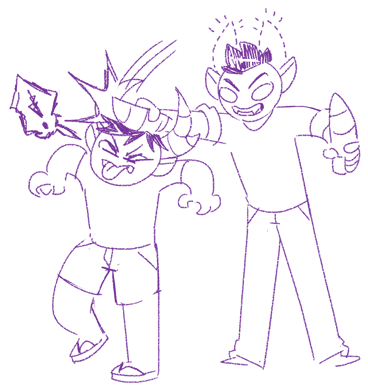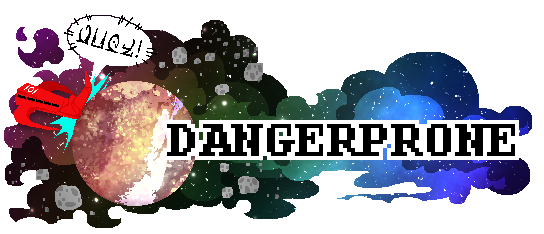Biology
Trolls are a bipedal, highly capable organism capable of critical thinking! A troll possesses gray skin, black hair, pointed ears, and a matching set of orange hued eyes, nails, and horns. The coloration of the troll's outer features are largely unchanging, though anomalies are known to occur, from white shocks of hair, skin conditions, blackened or blood hued nails, and a variety of other oddities that aren't quite egregious enough to consider a mutation.
Colors of base features aside, trolls come in rather wild varieties, many shapes and sizes. Big or small, tall or short, we've got them all. Horns are also known to come in virtually any shape and size, with up to six horns seated upon the crown of their skull. Teeth are also known to be incredibly varied, making regulated dental care rather difficult and occasionally dangerous. One troll may have blunt rounded teeth, another has horrible deep-sea needle teeth. So, you know.
All trolls are omnivorous by nature, able to choose their preferred source of sustenance. All that matters at the end of the day is the intake of nutrients and the body will find a way. After childhood though, it can be quite difficult for a troll to change their eating habits, their bodies having adapted to their diet during the formative period post wigglerhood. Ideally, a troll will eat a variety of things, allowing their internal systems to adapt to many kinds of foods instead of isolated single sources, as that may come back to haunt them later in life.
At this point, no one is entirely sure of it was by nature or necessity, but trolls are largely a nocturnal species. This is at the very least due to a long evolutionary history that has led them to having highly light sensitive eyes and occasionally quite sensitive skin. Trolls have physiologically adapted to a nighttime waking routine, but that does not preclude the occasional oddity. Without daywalkers as a threat and something to shield their eyes, a troll could enjoy daylight just fine.
Interestingly, trolls have rather impressive healing and regenerative abilities, their bodies naturally built to regrow lost teeth and able to take severe beatings without fully giving out.
Lifecycle

Every troll starts out as an egg and the slurry of genetic material congealing inside its translucent surface. Sound gross? Good, it is. It's a miracle that caretakers put up with tending to these things. Like, it's super gross, you can literally see the body growing inside there. And they like. Pulsate and stuff? Just imagine being in a dank dark cave with hundreds of these things stuck all over the floor. Now imagine stepping on one. Yeah.
Legitimately disgusting. And that's not even touching on the protective goop it rests in, keeping the dang thing from rolling away. The egg feels like a soft membrane, but is incredibly thick, intended to protect the wiggler forming inside.
 The larval state of the troll, a mighty wiggler has emerged from its egg. With the use of its horns and teeth, the wiggler has freed itself from the fleshy egg prison and consumed the leftover matter. Quite cleanly of them, really. And still disgusting.
The larval state of the troll, a mighty wiggler has emerged from its egg. With the use of its horns and teeth, the wiggler has freed itself from the fleshy egg prison and consumed the leftover matter. Quite cleanly of them, really. And still disgusting.
Most of the body is still soft and squishy, lacking most of the skeleton, but the head has taken shape quite well. Sort of. It's still kinda screwed up, but it's a start. As a wiggler, the troll's insectoid nature and roots are most obvious. Traditional speech is beyond a wiggler, what with the lack of vocal chords and a tongue, but they do possess special vocalization organs that rub and hit off each other to create clicks and drones, called chittering. Blood color is quite obvious immediately, affecting the pigmentation of both the larval body and the bulbous eyes. Comparable to a grub or caterpillar, the wiggler exists to consume until it has enough nutrients stored in its lil body to facilitate pupation. The first signs of what kind of troll will grow from the wiggler are shown in the orange hued horns and grey skin on the head, but most features will be shed and regrown after pupating.
 When the wiggler has gotten its fill of matter, it's time to break down those nutrients and grow. The wiggler will find a dark cozy spot to form a chrysalis in and begin an accelerated growth process. The liquefaction process breaks down quite selectively, but the reimmersion into a semi-viscous state is necessary for the growth process. The chrysalis is formed from the squishy outer body of the wiggler expanding and inflating. Surely, when done, a beautiful butterfly will emerge?
When the wiggler has gotten its fill of matter, it's time to break down those nutrients and grow. The wiggler will find a dark cozy spot to form a chrysalis in and begin an accelerated growth process. The liquefaction process breaks down quite selectively, but the reimmersion into a semi-viscous state is necessary for the growth process. The chrysalis is formed from the squishy outer body of the wiggler expanding and inflating. Surely, when done, a beautiful butterfly will emerge?
 The excess squishy flesh jacket and hardened pseudo teeth have been shed, replaced with something more permanent and mobile. Yes, lo and behold, the kid emerges.
The excess squishy flesh jacket and hardened pseudo teeth have been shed, replaced with something more permanent and mobile. Yes, lo and behold, the kid emerges.
See? A butterfly. Definitely a butterfly.
Analogous to a butterfly?
Okay no, it's not a butterfly.
The troll has taken the form that they will keep for the rest of their natural born life. Now a bipedal, complete with good old opposable thumbs, the kid can navigate much easier. Unlike the wiggler, blood color is no longer obvious without getting the blood outside the body. The eyes have reconfigured a bit, their orange irises developed and pupils turning to black. Trolls are most commonly equipped with black lips, a set of pointed ears, and orange hued nails. A proper skeleton is fully in place, complete with femurs and flanges- and look! Teeth! Wow those chompers. One of the only leftovers from their time as a wiggler are a troll's grubscars, placed where the extra legs of a wiggler merged into the main body, the chitin recycled and reused.
Fresh from the birthing caverns, the kid must learn to survive, obtain a lusus, and begin integrating with society.
 In due time the kid will grow into a teen by entering what is called puperty. Yes, the great plague of hormones and budding development of adulthood, a teen faces many trials as their body rebels against them. This change does not come quietly though; it arrives with a bang, signaled by a layer of skin sloughing off after a night of skeletal pains and horn pedicle aches. A kid will go to sleep and awaken a teenager, left in a wrapper of their own dead cells. Thankfully, they don't eat it this time. Usually. Depends on the troll. The newly minted teen will awake famished, having spent much nutrients on the growth. The fun part is, it's just the beginning!
In due time the kid will grow into a teen by entering what is called puperty. Yes, the great plague of hormones and budding development of adulthood, a teen faces many trials as their body rebels against them. This change does not come quietly though; it arrives with a bang, signaled by a layer of skin sloughing off after a night of skeletal pains and horn pedicle aches. A kid will go to sleep and awaken a teenager, left in a wrapper of their own dead cells. Thankfully, they don't eat it this time. Usually. Depends on the troll. The newly minted teen will awake famished, having spent much nutrients on the growth. The fun part is, it's just the beginning!
Yes indeedy, many changes are to come. With each growth spurt comes a new molt, allowing skin to adapt to the changes in size and shape as their horns slowly grow towards their full size. Having never lost the ability to vocalize chirps and chitters, the tune of it begins to grow over the course of their teenage molts into pattern that will be unique to that troll. It's a time of changes, the pace of which will be different for everyone. Some start early, and some bloom late, and the length of puperty is random at best!
As a teenager nears the next and final phase of their life, many of these changes begin to settle, the signal of which being their first true molt. And just what does that mean? First true molt? I've been molting on and off for the past who knows how long and you're telling me it wasn't a real molt!? Sort of.
A molt for a teenager mid puperty and a molt for an adult are two slightly different things, alike in nature, but with some different key details.
As said, as a teen nears adulthood, they will encounter a true molt, where they will shed their first pair of horns at last. You heard me right. What, you didn't know these things came off? If you lost them or broke your horns, not to worry, there are more where that came from. By the time of a first true molt, most changes of the teen's body have begun to settle and the signals of adulthood have seeped in.

Soon enough, the troll will have become an adult! They grow up so fast. As an adult, true molts are simply an annual occurrence once a year, usually near or on a troll's wriggling date. An adult troll will shed their horns and outer layer of skin, but rather than the miserable roller coaster that a teenager faces, for an adult it's more like a detox. A lot of nasty toxins and other junk get shed and they even enjoy a scant month or two free of the extra head weight. Turnaround time for horns is pretty quick, only taking a month or two to regrow, shiny and just as good as the old ones. By adulthood, a troll's horns have reached their full size and will grow back same as the old. Unless someone was to say jack up their pedicle in between molt and regrowth. Then yeah, your horns are kind of ruined forever probably. The irises that turned black after wiggler pupation have once more pigmented with a troll's blood color, proudly displaying for all to see.
Eventually, whether through battle, dumb accident, or old age, a troll dies. For some, death is the end. For others, well.
Alternative Stages
Ghost
"Boo Motherfucker."
Possessed
"Kinda roomy in here."
Robot
"I'm a gay robot."

